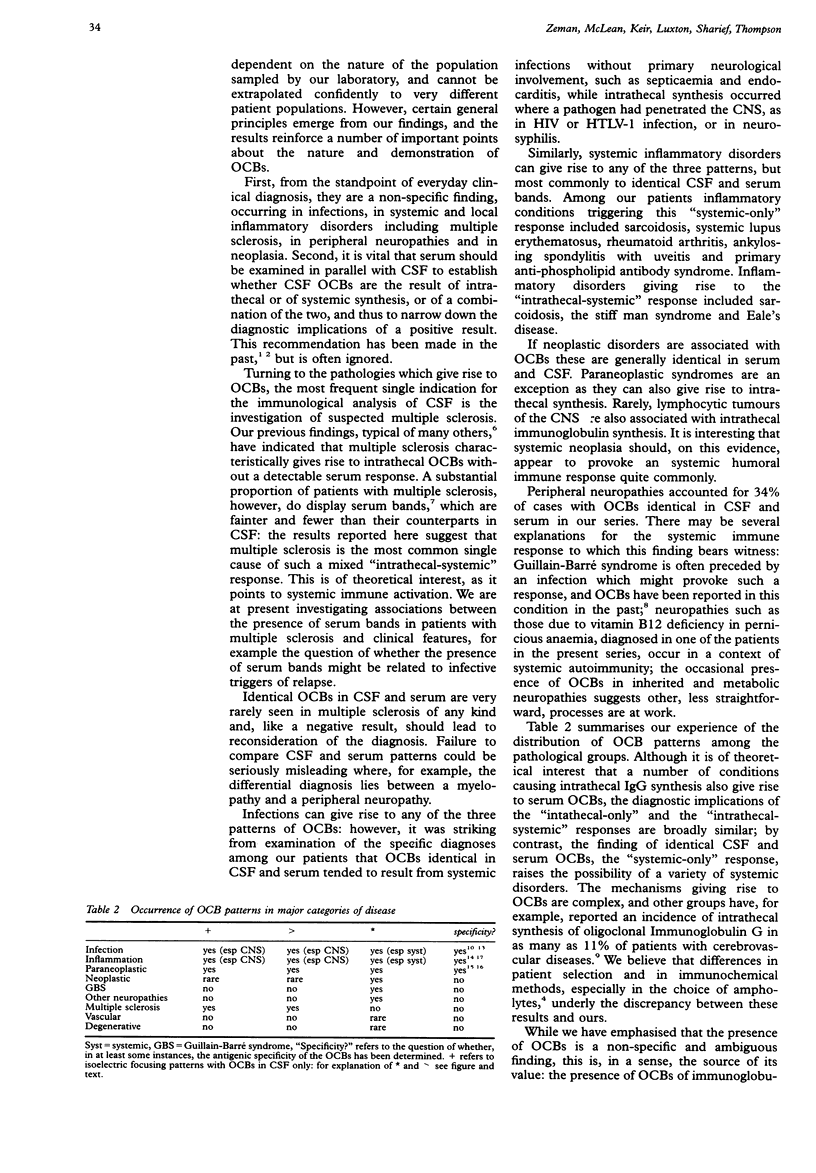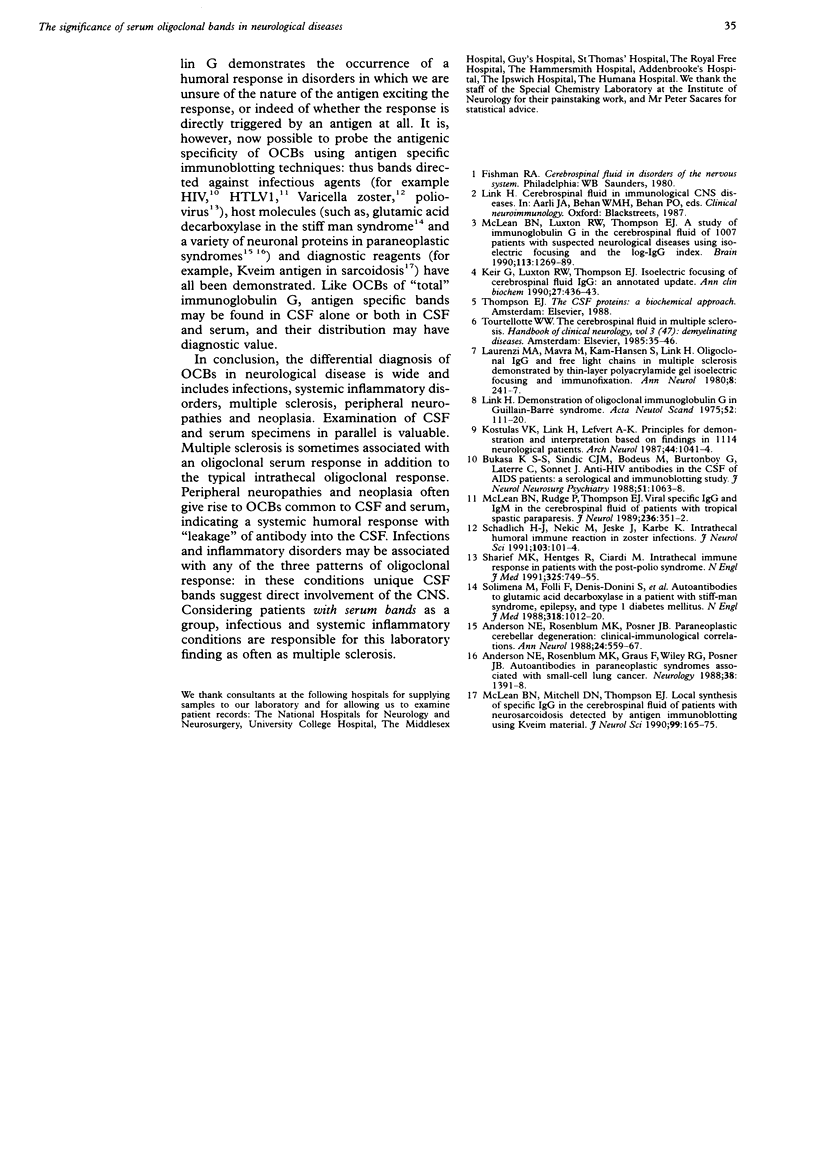Abstract
The presence of oligoclonal bands (OCBs) of immunoglobulin G (IgG) in CSF provides evidence for the occurrence of a humoral immune response, but it is not always appreciated that the oligoclonal IgG may have originated in the serum. To determine the diagnostic significance of serum OCBs 146 patients with serum OCBs were identified among 1874 patients with suspected neurological disorders (7.6%). Clear diagnoses had been made in 112 of these patients: in 56 identical CSF and serum bands were present, revealing a systemic immune response, while in 46 additional unique CSF bands indicated that intrathecal IgG synthesis was also occurring. In the first group neoplasia and peripheral neuropathies accounted for over 50% of the diagnoses, infections and systemic inflammatory disorders for 32%, and multiple sclerosis was diagnosed in only one case. These figures contrast considerably with those reported for patients with CSF OCBs alone. Diagnoses in the second group of patients, with unique CSF OCBs in addition to serum OCBs, resembled those among patients with CSF OCBs alone. Examining CSF and serum in parallel for OCBs of IgG provides more diagnostic information than examining CSF alone, and the latter is potentially misleading.
Full text
PDF



Images in this article
Selected References
These references are in PubMed. This may not be the complete list of references from this article.
- Anderson N. E., Rosenblum M. K., Graus F., Wiley R. G., Posner J. B. Autoantibodies in paraneoplastic syndromes associated with small-cell lung cancer. Neurology. 1988 Sep;38(9):1391–1398. doi: 10.1212/wnl.38.9.1391. [DOI] [PubMed] [Google Scholar]
- Anderson N. E., Rosenblum M. K., Posner J. B. Paraneoplastic cerebellar degeneration: clinical-immunological correlations. Ann Neurol. 1988 Oct;24(4):559–567. doi: 10.1002/ana.410240413. [DOI] [PubMed] [Google Scholar]
- Bukasa K. S., Sindic C. J., Bodeus M., Burtonboy G., Laterre C., Sonnet J. Anti-HIV antibodies in the CSF of AIDS patients: a serological and immunoblotting study. J Neurol Neurosurg Psychiatry. 1988 Aug;51(8):1063–1068. doi: 10.1136/jnnp.51.8.1063. [DOI] [PMC free article] [PubMed] [Google Scholar]
- Keir G., Luxton R. W., Thompson E. J. Isoelectric focusing of cerebrospinal fluid immunoglobulin G: an annotated update. Ann Clin Biochem. 1990 Sep;27(Pt 5):436–443. doi: 10.1177/000456329002700504. [DOI] [PubMed] [Google Scholar]
- Kostulas V. K., Link H., Lefvert A. K. Oligoclonal IgG bands in cerebrospinal fluid. Principles for demonstration and interpretation based on findings in 1114 neurological patients. Arch Neurol. 1987 Oct;44(10):1041–1044. doi: 10.1001/archneur.1987.00520220043014. [DOI] [PubMed] [Google Scholar]
- Laurenzi M. A., Mavra M., Kam-Hansen S., Link H. Oligoclonal IgG and free chains in multiple sclerosis demonstrated by thin-layer polyacrylamide gel isoelectric focusing and immunofixation. Ann Neurol. 1980 Sep;8(3):241–247. doi: 10.1002/ana.410080304. [DOI] [PubMed] [Google Scholar]
- Link H. Demonstration of oligoclonal immunoglobulin G IN Guillain-Barré syndrome. Acta Neurol Scand. 1975 Aug;52(2):111–120. doi: 10.1111/j.1600-0404.1975.tb05765.x. [DOI] [PubMed] [Google Scholar]
- McLean B. N., Luxton R. W., Thompson E. J. A study of immunoglobulin G in the cerebrospinal fluid of 1007 patients with suspected neurological disease using isoelectric focusing and the Log IgG-Index. A comparison and diagnostic applications. Brain. 1990 Oct;113(Pt 5):1269–1289. doi: 10.1093/brain/113.5.1269. [DOI] [PubMed] [Google Scholar]
- McLean B. N., Mitchell D. N., Thompson E. J. Local synthesis of specific IgG in the cerebrospinal fluid of patients with neurosarcoidosis detected by antigen immunoblotting using Kveim material. J Neurol Sci. 1990 Nov;99(2-3):165–175. doi: 10.1016/0022-510x(90)90153-e. [DOI] [PubMed] [Google Scholar]
- McLean B. N., Rudge P., Thompson E. J. Viral specific IgG and IgM antibodies in the CSF of patients with tropical spastic paraparesis. J Neurol. 1989 Sep;236(6):351–352. doi: 10.1007/BF00314379. [DOI] [PubMed] [Google Scholar]
- Schädlich H. J., Nekic M., Jeske J., Karbe H. Intrathecal humoral immune reaction in zoster infections. J Neurol Sci. 1991 May;103(1):101–104. doi: 10.1016/0022-510x(91)90291-e. [DOI] [PubMed] [Google Scholar]
- Sharief M. K., Hentges R., Ciardi M. Intrathecal immune response in patients with the post-polio syndrome. N Engl J Med. 1991 Sep 12;325(11):749–755. doi: 10.1056/NEJM199109123251101. [DOI] [PubMed] [Google Scholar]
- Solimena M., Folli F., Denis-Donini S., Comi G. C., Pozza G., De Camilli P., Vicari A. M. Autoantibodies to glutamic acid decarboxylase in a patient with stiff-man syndrome, epilepsy, and type I diabetes mellitus. N Engl J Med. 1988 Apr 21;318(16):1012–1020. doi: 10.1056/NEJM198804213181602. [DOI] [PubMed] [Google Scholar]



